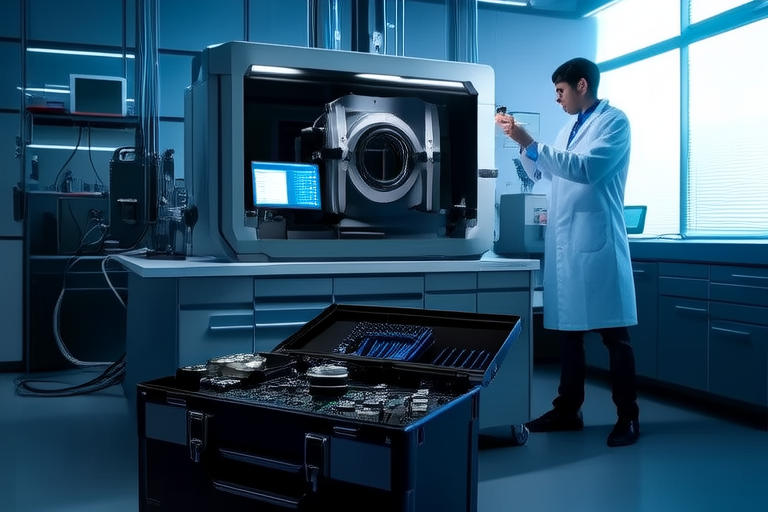“`html
Unlocking the Potential of Computer Vision in Everyday Applications
Introduction
Computer vision, a subset of artificial intelligence (AI), involves teaching computers to interpret and understand the visual world through digital images or videos. It enables machines to process, analyze, and make decisions based on visual data, much like human vision. In today’s rapidly evolving technological landscape, computer vision plays an increasingly crucial role in driving innovation across various industries. From healthcare to transportation, computer vision is transforming everyday applications, offering unprecedented opportunities for automation, efficiency, and enhanced user experiences.
The evolution of computer vision has been marked by significant advancements in algorithms, hardware, and data processing capabilities. Initially limited to simple tasks like pattern recognition, modern computer vision systems now leverage deep learning techniques, particularly convolutional neural networks (CNNs), to perform complex analyses with high accuracy. As these technologies continue to mature, the relevance of computer vision in everyday applications is set to grow exponentially.
Understanding Computer Vision
Definition: Computer vision refers to the ability of a machine to interpret and understand visual information from the world, similar to human vision. It involves capturing, processing, analyzing, and making sense of digital images or videos.
Core Principles: At its core, computer vision relies on several key principles, including image acquisition, preprocessing, feature extraction, and decision-making. These processes enable machines to recognize objects, scenes, and patterns within visual data.
Key Technologies and Algorithms:
- Convolutional Neural Networks (CNNs): CNNs are a type of deep learning model specifically designed for processing grid-like data such as images. They excel at identifying patterns and features within images, making them essential for tasks like object detection and image classification.
- Object Detection: This technique allows computers to identify and locate objects within an image or video. Popular object detection frameworks include YOLO (You Only Look Once) and SSD (Single Shot MultiBox Detector).
- Image Segmentation: Image segmentation involves dividing an image into multiple segments or regions, each representing different objects or parts of the scene. Semantic segmentation labels each pixel, while instance segmentation distinguishes between individual objects.
Applications in Everyday Life
Subsection A: Healthcare
Computer vision is revolutionizing the healthcare industry by improving diagnostic accuracy, enhancing patient care, and enabling new treatment methods. One of the most notable applications is in medical imaging analysis, where computer vision algorithms can detect abnormalities in X-rays, MRIs, and CT scans with greater precision than human radiologists. For example, deep learning models have been developed to accurately diagnose conditions like pneumonia, cancer, and diabetic retinopathy.
In addition to diagnostics, computer vision is also being used in robotic surgery, where cameras and sensors provide surgeons with enhanced visualization during procedures. Patient monitoring systems that use computer vision can track vital signs and alert医护人员,计算机视觉正在通过提高诊断准确性、改善患者护理和提供新的治疗方法来彻底改变医疗行业。其中一个最显著的应用是在医学影像分析中,计算机视觉算法可以比人类放射科医生更精确地检测X光片、MRI和CT扫描中的异常。例如,已经开发了深度学习模型,可以准确诊断肺炎、癌症和糖尿病视网膜病变等疾病。
此外,在机器人手术中,计算机视觉也得到了应用,摄像机和传感器为外科医生在手术过程中提供了增强的可视化效果。患者监测系统使用计算机视觉可以跟踪生命体征并在出现异常时发出警报。随着技术的进步,计算机视觉在医疗领域的潜力将继续扩大,有望实现更个性化的治疗方案和远程医疗。
Subsection B: Retail and E-commerce
Computer vision is transforming the retail and e-commerce sectors by enhancing customer experiences, optimizing operations, and creating new business models. In retail stores, computer vision-powered systems can automatically track inventory levels, reducing the need for manual stocktaking. For instance, Amazon Go stores use computer vision to monitor customers’ interactions with products and charge them accordingly without requiring checkout lines.
Moreover, computer vision enables personalized shopping experiences by analyzing customer behavior and preferences. Retailers can offer tailored product recommendations and promotions based on real-time data collected through cameras and sensors. As computer vision technology continues to advance, we can expect more innovative applications in areas such as virtual fitting rooms and interactive displays.
Subsection C: Transportation
Computer vision is playing a pivotal role in advancing autonomous vehicles and smart transportation systems. Autonomous vehicles rely heavily on computer vision to perceive their surroundings, detect obstacles, and make informed decisions. Companies like Tesla and Google’s Waymo are at the forefront of developing self-driving cars that use advanced computer vision algorithms to navigate roads safely and efficiently.
In addition to autonomous driving, computer vision is also being integrated into traffic management systems and smart city initiatives. These systems can analyze traffic patterns, optimize signal timing, and improve overall traffic flow. By leveraging computer vision, cities can become more sustainable and efficient, reducing congestion and pollution.
Subsection D: Smart Home Devices
Computer vision is powering a wide range of smart home devices, enhancing convenience and security for homeowners. Facial recognition technology, for example, allows smart locks to authenticate users and grant access based on their identity. Gesture control systems enable users to interact with smart appliances and entertainment devices without needing physical contact.
Virtual assistants like Amazon Alexa and Google Assistant are also incorporating computer vision to provide more intuitive and personalized experiences. These devices can recognize individuals, understand context, and respond accordingly. As computer vision becomes more sophisticated, we can expect even more advanced functionalities in smart home ecosystems.
Subsection E: Entertainment and Media
Computer vision is transforming the entertainment and media industries by enabling new forms of interaction and content creation. Augmented reality (AR) experiences, for instance, allow users to overlay digital elements onto the real world, creating immersive and interactive environments. Video games are also benefiting from computer vision, with motion capture systems and gesture-based controls enhancing gameplay.
Furthermore, computer vision is being used in content creation tools to automate tasks like video editing and special effects. As technology advances, we can anticipate more innovative applications in areas such as virtual production and live streaming.
Challenges and Ethical Considerations
While computer vision offers numerous benefits, it also presents several challenges and ethical considerations. Privacy concerns are a major issue, as computer vision systems often require access to sensitive personal data. Ensuring data privacy and security is paramount to building trust with users.
Data bias is another challenge that must be addressed. If training datasets are not representative of diverse populations, computer vision models may produce biased results. Developers must strive for fairness and inclusivity when designing and deploying these systems.
Computational limitations also pose challenges, particularly in real-time applications. Processing large amounts of visual data requires significant computational power, which can be costly and resource-intensive. However, ongoing advancements in hardware and cloud computing are helping to overcome these barriers.
To ensure responsible implementation, best practices such as transparent data usage policies, regular audits, and continuous improvement are essential. By addressing these challenges proactively, we can harness the full potential of computer vision while minimizing risks.
Conclusion
Computer vision is unlocking new possibilities across a wide range of industries, from healthcare to entertainment. Its ability to interpret and understand visual data is transforming everyday applications, offering unprecedented opportunities for automation, efficiency, and enhanced user experiences. As technology continues to evolve, the potential for computer vision to drive innovation and solve complex problems will only increase.
Looking ahead, we can expect even more advanced applications of computer vision in areas like personalized medicine, autonomous transportation, and immersive entertainment. By embracing these innovations responsibly, we can create a future where computer vision plays a central role in shaping our world.
“`


